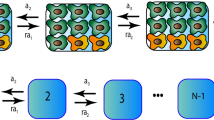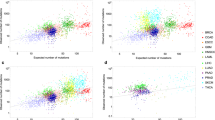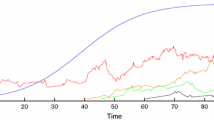Abstract
In this work, we consider the problem of estimating the probability for a specific random genetic mutation to be present in a tumor of a given size. Previous mathematical models have been based on stochastic methods where the tumor was assumed to be homogeneous and, on average, growing exponentially. In contrast, we are able to obtain analytical results for cases where the exponential growth of cancer has been replaced by other, arguably more realistic types of growth of a heterogeneous tumor cell population. Our main result is that the probability that a given random mutation will be present by the time a tumor reaches a certain size, is independent of the type of curve assumed for the average growth of the tumor, at least for a general class of growth curves. The same is true for the related estimate of the expected number of mutants present in a tumor of a given size, if mutants are indeed present.

Similar content being viewed by others
References
Abkowitz, J. L., Persik, M. T., Shelton, G. H., Ott, R. L., Kiklevich, J. V., Catlin, S. N., & Guttorp, P. (1995). Behavior of hematopoietic stem cells in a large animal. Proc. Natl. Acad. Sci. USA, 92, 2031–2035.
Bellomo, N., Li, N. K., & Maini, P. K. (2008). On the foundations of cancer modeling: selected topics, speculations, and perspectives. Math. Models Methods Appl. Sci., 18, 593–646.
Booth, C., & Potten, C. S. (2000). Gut instincts: Thoughts on intestinal epithelial stem cells. J. Clin. Invest., 105, 1493–1499.
Coldman, A. J., & Goldie, J. H. (1985). Role of mathematical modeling in protocol formulation in cancer chemotherapy. Cancer Treat. Rep., 69(10), 1041–1048.
Coldman, A. J., & Goldie, J. H. (1986). A stochastic model for the origin and treatment of tumors containing drug-resistant cells. Bull. Math. Biol., 48(3–4), 279–292.
Gaffney, E. A. (2005). The mathematical modelling of adjuvant chemotherapy scheduling: incorporating the effects of protocol rest phases and pharmacokinetics. Bull. Math. Biol., 67(3), 563–611.
Giebel, B., Zhang, T., Beckmann, J., Spanholtz, J., Wernet, P., Ho, A. D., & Punzel, M. (2006). Primitive human hematopoietic cells give rise to differentially specified daughter cells upon their initial cell division. Blood, 107, 2146–2152.
Goldie, J. H., & Coldman, A. J. (1979). A mathematical model for relating the drug sensitivity of tumors to their spontaneous mutation rate. Cancer Treat. Rep., 63(11–12), 1727–1733.
Goldie, J. H., & Coldman, A. J. (1983a). A model for resistance of tumor cells to cancer chemotherapeutic agents. Math. Biosci., 65, 291–307.
Goldie, J. H., & Coldman, A. J. (1983b). Quantitative model for multiple levels of drug resistance in clinical tumors. Cancer Treat. Rep., 67(10), 923–931.
Goldie, J. H., & Coldman, A. J. (1998). Drug resistance in cancer: mechanisms and models. Cambridge: Cambridge University Press.
Goldie, J. H., Coldman, A. J., & Gudaskas, G. A. (1982). Rationale for the use of alternating non-cross resistant chemotherapy. Cancer Treat. Rep., 66(3), 439–449.
Hanahan, D., & Weinberg, R. A. (2000). The hallmarks of cancer. Cell, 100, 57–70.
Harnevo, L. E., & Agur, Z. (1991). The dynamics of gene amplification described as a multitype compartmental model and as a branching process. Math. Biosci., 103(1), 115–138.
Harnevo, L. E., & Agur, Z. (1993). Use of mathematical models for understanding the dynamics of gene amplification. Mutat. Res., 292(1), 17–24.
Iwasa, Y., Nowak, M. A., & Michor, F. (2006). Evolution of resistance during clonal expansion. Genetics, 172, 2557–2566.
Kimmel, M., & Axelrod, D. E. (1990). Mathematical models of gene amplification with applications to cellular drug resistance and tumorigenicity. Genetics, 125(3), 633–644.
Komarova, N. (2006). Stochastic modeling of drug resistance in cancer. J. Theor. Biol., 239(3), 351–366.
Komarova, N., & Wodarz, D. (2005). Drug resistance in cancer: principles of emergence and prevention. Proc. Natl. Acad. Sci. U.S.A., 102(27), 9714–9719.
Komarova, N., & Wodarz, D. (2009). Combination therapies against chronic myeloid leukemia: short-term versus long-term strategies. Cancer Res., 69(11), 4904–4910.
Komarova, N., Katouli, A. A., & Wodarz, D. (2009). Combination of two but not three current targeted drugs can improve therapy of chronic myeloid leukemia. PLoS ONE, 4(2), e4423.
Luria, S. E., & Delbruck, M. (1943). Mutation of bacteria from virus sensitivity to virus resistance. Genetics, 28, 491–511.
McKenzie, J. L., Gan, O. I., Doedens, M., Wang, J. C., & Dick, J. E. (2006). Individual stem cells with highly variable proliferation and self-renewal properties comprise the human hematopoietic stem cell compartment. Nat. Immunol., 7, 1225–1233.
Moolgavkar, S. H. (1986). Carcinogenesis modeling: from molecular biology to epidemiology. Annu. Rev. Public Health, 7, 151–169.
Morrison, S. J., & Kimble, J. (2006). Asymmetric and symmetric stem-cell divisions in development and cancer. Nature, 441, 1068–1074.
Murray, J. M. (1997). The optimal scheduling of two drugs with simple resistance for a problem in cancer chemotherapy. IMA J. Math. Appl. Med. Biol., 14, 283–303.
Nakasu, S., Nakasu, Y., Fukami, T., Jito, J., & Nozaki, K. (2010). Growth curve analysis of asymptomatic and symptomatic meningiomas. J. Neurooncology. doi:10.1007/s11060-010-0319-1.
Panetta, J. C., & Adam, J. (1995). A mathematical model of cycle-specific chemotherapy. Math. Comput. Model., 22, 67–82.
Retsky, J. (2011). Metronomic chemotherapy was originally designed and first used in 1994 for early stage cancer—why s it taking so long to proceed? Bioequiv. Availab. 3(4). doi:10.4172/jbb.100000e6.
Teicher, B. A. (2006). Cancer drug resistance. Totowa: Humana Press.
Tomasetti, C., & Levy, D. (2010a). An elementary approach to modeling drug resistance in cancer. Math. Biosci. Eng., 7(4), 905–918.
Tomasetti, C., & Levy, D. (2010b). Drug resistance always depends on the turnover rate. In K. E. Herold & W. E. Bentley (Eds.), IFMBE proceedings (Vol. 32). New York: Springer.
Tomasetti, C., & Levy, D. (2010c). Role of symmetric and asymmetric division of stem cells in developing drug resistance. Proc. Natl. Acad. Sci. USA, 107(39), 16766–16771.
Wu, M., Kwon, H. Y., Rattis, F., Blum, J., Zhao, C., Ashkenazi, R., Jackson, T. L., Gaiano, N., Oliver, T., & Reya, T. (2007). Imaging hematopoietic precursor division in real time. Cell Stem Cell, 1, 541–554.
Yatabe, Y., Tavare, S., & Shibata, D. (2001). Investigating stem cells in human colon by using methylation patterns. Proc. Natl. Acad. Sci. USA, 98, 10839–10844.
Zheng, Q. (1999). Progress of a half century in the study of the Luria–Delbrück distribution. Math. Biosci., 162, 1–32.
Acknowledgements
The author wishes to thank Professor Dmitry Dolgopyat for his helpful discussions and the reviewers for their valuable comments. The work of CT was supported in part by the National Institute of Health under Grant T32 CA009337, by the joint National Science Foundation/National Institute of General Medical Sciences program under Grant DMS-0758374 and by the National Cancer Institute under Grant R01CA130817.
Author information
Authors and Affiliations
Corresponding author
Rights and permissions
About this article
Cite this article
Tomasetti, C. On the Probability of Random Genetic Mutations for Various Types of Tumor Growth. Bull Math Biol 74, 1379–1395 (2012). https://doi.org/10.1007/s11538-012-9717-1
Received:
Accepted:
Published:
Issue Date:
DOI: https://doi.org/10.1007/s11538-012-9717-1




